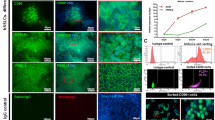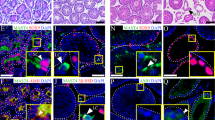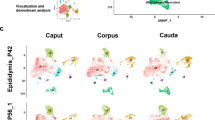Abstract
Although the roles of the Hippo pathway in organogenesis and tumorigenesis have been well studied in multiple organs, its role in sperm maturation and male fertility has not been investigated. The initial segment (IS) of the epididymis plays a critical role in sperm maturation. IS differentiation is governed by ERK1/2, but the mechanisms of ERK1/2 activation in IS are not fully understood. Here we show that double knockout (dKO) of mammalian sterile 20-like kinases 1 and 2 (Mst1 and Mst2), homologs of Hippo in Drosophila, in the epididymal epithelium led to male infertility in mice. Sperm in the cauda epididymides of mutant mice were immotile with flagellar angulation and severely disorganized structures. Loss of Mst1/2 activated YAP and increased proliferation and cell death in all the segments of epididymis. The mutant mice showed substantially suppressed MEK/ERK signaling in the IS and failed IS differentiation. Deletion of Yap restored the reduced MEK/ERK signaling, and partially rescued the defective IS differentiation and fertility in Mst1/2 dKO mice. Our results demonstrate that YAP inhibits the MEK/ERK pathway in IS epithelial cells, and MST1/2 control IS differentiation and fertility at least partially by repressing YAP. Taken together, the Hippo pathway is essential for sperm maturation and male fertility.
Similar content being viewed by others
Log in or create a free account to read this content
Gain free access to this article, as well as selected content from this journal and more on nature.com
or
References
Jiang FX, Temple-Smith P, Wreford NG. Postnatal differentiation and development of the rat epididymis: a stereological study. Anat Rec. 1994;238:191–8.
Jegou B, Le Gac F, de Kretser DM. Seminiferous tubule fluid and interstitial fluid production. I. Effects of age and hormonal regulation in immature rats. Biol Reprod. 1982;27:590–5.
Sun EL, Flickinger CJ. Development of cell types and of regional differences in the postnatal rat epididymis. Am J Anat. 1979;154:27–55.
Jun HJ, Roy J, Smith TB, Wood LB, Lane K, Woolfenden S, et al. ROS1 signaling regulates epithelial differentiation in the epididymis. Endocrinology. 2014;155:3661–73.
Sonnenberg-Riethmacher E, Walter B, Riethmacher D, Godecke S, Birchmeier C. The c-ros tyrosine kinase receptor controls regionalization and differentiation of epithelial cells in the epididymis. Genes Dev. 1996;10:1184–93.
Xu B, Washington AM, Hinton BT. PTEN signaling through RAF1 proto-oncogene serine/threonine kinase (RAF1)/ERK in the epididymis is essential for male fertility. Proc Natl Acad Sci USA. 2014;111:18643–8.
Xu B, Yang L, Lye RJ, Hinton BT. p-MAPK1/3 and DUSP6 regulate epididymal cell proliferation and survival in a region-specific manner in mice. Biol Reprod. 2010;83:807–17.
Xu B, Abdel-Fattah R, Yang L, Crenshaw SA, Black MB, Hinton BT. Testicular lumicrine factors regulate ERK, STAT, and NFKB pathways in the initial segment of the rat epididymis to prevent apoptosis. Biol Reprod. 2011;84:1282–91.
Xu B, Yang L, Hinton BT. The Role of fibroblast growth factor receptor substrate 2 (FRS2) in the regulation of two activity levels of the components of the extracellular signal-regulated kinase (ERK) pathway in the mouse epididymis. Biol Reprod. 2013;89:48.
Xu B, Washington AM, Hinton BT. Initial segment differentiation begins during a critical window and is dependent upon lumicrine factors and SRC proto-oncogene (SRC) in the mouse. Biol Reprod. 2016;95:15.
Yeung CH, Sonnenberg-Riethmacher E, Cooper TG. Infertile spermatozoa of c-ros tyrosine kinase receptor knockout mice show flagellar angulation and maturational defects in cell volume regulatory mechanisms. Biol Reprod. 1999;61:1062–9.
Krapf D, Ruan YC, Wertheimer EV, Battistone MA, Pawlak JB, Sanjay A, et al. cSrc is necessary for epididymal development and is incorporated into sperm during epididymal transit. Dev Biol. 2012;369:43–53.
Pan D. The hippo signaling pathway in development and cancer. Dev Cell. 2010;19:491–505.
Yu FX, Zhao B, Guan KL. Hippo pathway in organ size control, tissue homeostasis, and cancer. Cell. 2015;163:811–28.
Koo JH, Guan KL. Interplay between YAP/TAZ and Metabolism. Cell Metab. 2018;28:196–206.
Misra JR, Irvine KD. The Hippo signaling network and its biological functions. Annu Rev Genet. 2018;52:65–87.
Zhou D, Medoff BD, Chen L, Li L, Zhang XF, Praskova M, et al. The Nore1B/Mst1 complex restrains antigen receptor-induced proliferation of naive T cells. Proc Natl Acad Sci USA. 2008;105:20321–6.
Song H, Mak KK, Topol L, Yun K, Hu J, Garrett L, et al. Mammalian Mst1 and Mst2 kinases play essential roles in organ size control and tumor suppression. Proc Natl Acad Sci USA. 2010;107:1431–6.
Zhou D, Conrad C, Xia F, Park JS, Payer B, Yin Y, et al. Mst1 and Mst2 maintain hepatocyte quiescence and suppress hepatocellular carcinoma development through inactivation of the Yap1 oncogene. Cancer Cell. 2009;16:425–38.
Wu H, Wei L, Fan F, Ji S, Zhang S, Geng J, et al. Integration of Hippo signalling and the unfolded protein response to restrain liver overgrowth and tumorigenesis. Nat Commun. 2015;6:6239.
Fan F, He Z, Kong LL, Chen Q, Yuan Q, Zhang S, et al. Pharmacological targeting of kinases MST1 and MST2 augments tissue repair and regeneration. Sci Transl Med. 2016;8:352ra108.
Kim W, Khan SK, Gvozdenovic-Jeremic J, Kim Y, Dahlman J, Kim H, et al. Hippo signaling interactions with Wnt/beta-catenin and Notch signaling repress liver tumorigenesis. J Clin Invest. 2017;127:137–52.
Loforese G, Malinka T, Keogh A, Baier F, Simillion C, Montani M, et al. Impaired liver regeneration in aged mice can be rescued by silencing Hippo core kinases MST1 and MST2. EMBO Mol Med. 2017;9:46–60.
Hagenbeek TJ, Webster JD, Kljavin NM, Chang MT, Pham T, Lee HJ, et al. The Hippo pathway effector TAZ induces TEAD-dependent liver inflammation and tumors. Sci Signal. 2018;11:eaaj1757.
Kim W, Khan SK, Liu Y, Xu R, Park O, He Y, et al. Hepatic Hippo signaling inhibits protumoural microenvironment to suppress hepatocellular carcinoma. Gut. 2018;67:1692–703.
Cai J, Zhang N, Zheng Y, de Wilde RF, Maitra A, Pan D. The Hippo signaling pathway restricts the oncogenic potential of an intestinal regeneration program. Genes Dev. 2010;24:2383–8.
Zhou D, Zhang Y, Wu H, Barry E, Yin Y, Lawrence E, et al. Mst1 and Mst2 protein kinases restrain intestinal stem cell proliferation and colonic tumorigenesis by inhibition of Yes-associated protein (Yap) overabundance. Proc Natl Acad Sci USA. 2011;108:E1312–20.
George NM, Day CE, Boerner BP, Johnson RL, Sarvetnick NE. Hippo signaling regulates pancreas development through inactivation of Yap. Mol Cell Biol. 2012;32:5116–28.
Li W, Deng Y, Feng B, Mak KK. Mst1/2 kinases modulate glucose uptake for osteoblast differentiation and bone formation. J Bone Min Res. 2018;33:1183–95.
Shao X, Somlo S, Igarashi P. Epithelial-specific Cre/lox recombination in the developing kidney and genitourinary tract. J Am Soc Nephrol. 2002;13:1837–46.
Schell C, Kretz O, Liang W, Kiefer B, Schneider S, Sellung D, et al. The rapamycin-sensitive complex of mammalian target of rapamycin is essential to maintain male fertility. Am J Pathol. 2016;186:324–36.
Cornwall GA. New insights into epididymal biology and function. Hum Reprod Update. 2009;15:213–27.
Qin F, Tian J, Zhou D, Chen L. Mst1 and Mst2 kinases: regulations and diseases. Cell Biosci. 2013;3:31.
Sipila P, Bjorkgren I. Segment-specific regulation of epididymal gene expression. Reproduction. 2016;152:R91–9.
Tumaneng K, Schlegelmilch K, Russell RC, Yimlamai D, Basnet H, Mahadevan N, et al. YAP mediates crosstalk between the Hippo and PI(3)K-TOR pathways by suppressing PTEN via miR-29. Nat Cell Biol. 2012;14:1322–9.
Marais R, Light Y, Paterson HF, Marshall CJ. Ras recruits Raf-1 to the plasma membrane for activation by tyrosine phosphorylation. EMBO J. 1995;14:3136–45.
Pijuan-Galito S, Tamm C, Anneren C. Serum Inter-alpha-inhibitor activates the Yes tyrosine kinase and YAP/TEAD transcriptional complex in mouse embryonic stem cells. J Biol Chem. 2014;289:33492–502.
Romano D, Nguyen LK, Matallanas D, Halasz M, Doherty C, Kholodenko BN, et al. Protein interaction switches coordinate Raf-1 and MST2/Hippo signalling. Nat Cell Biol. 2014;16:673–84.
Chang YC, Wu JW, Hsieh YC, Huang TH, Liao ZM, Huang YS, et al. Rap1 negatively regulates the Hippo pathway to polarize directional protrusions in collective cell migration. Cell Rep. 2018;22:2160–75.
Uchida M, Enomoto A, Fukuda T, Kurokawa K, Maeda K, Kodama Y, et al. Dok-4 regulates GDNF-dependent neurite outgrowth through downstream activation of Rap1 and mitogen-activated protein kinase. J Cell Sci. 2006;119:3067–77.
Acknowledgements
We thank Dr Sylvie Breton (Massachusetts General Hospital) for providing the AQP9 and B1-ATPase antibodies, Dr Yu Huang (The Chinese University of Hong Kong) for the financial support for RNA-Seq, Dr Wen-Liang Zhou (Sun Yat-Sen University) for PC-1 cells, Dr Xiangjian Zheng (Tianjin Medical University) for the help with X-gal staining, and Sharon Y.C. Ruan (The Hong Kong Polytechnic University) for helpful discussions.
We are grateful to Josie Lai and Jean Kung (The Chinese University of Hong Kong) for technical assistance with the electronic microscopy and Corinna Au (The Chinese University of Hong Kong) for assistance with histology.
Author information
Authors and Affiliations
Corresponding author
Ethics declarations
Conflict of interest
The authors declare that they have no conflict of interest.
Additional information
Publisher’s note Springer Nature remains neutral with regard to jurisdictional claims in published maps and institutional affiliations.
Edited by E. Baehrecke
Supplementary information
41418_2020_544_MOESM6_ESM.tif
Supplemental Figure 5. Comparison of epithelial height of region I of initial segment between WT and Mst1/2 dKO mice at 8 weeks of age.
41418_2020_544_MOESM7_ESM.tif
Supplemental Figure 6. Phosphorylation levels of the kinases upstream of ERK1/2 and protein levels of MST1, MST2 and YAP in the initial segment and cauda epididymis between WT and Mst1/2 dKO mice.
41418_2020_544_MOESM8_ESM.tif
Supplemental Figure 7. H&E-stained paraffin-embedded sections of caput epididymides from WT and Mst1/2 dKO mice at 4 and 8 weeks of age.
41418_2020_544_MOESM10_ESM.tif
Supplemental Figure 9. Comparison of epithelial height of initial segment between WT and Mst1/Mst2/Yap tKO mice at 8 weeks of age. Supplemental Figure 10. The top GO terms associated with molecular functions of differently expressed genes between the initial segments of WT and Mst1/Mst2/Yap tKO mice.
Rights and permissions
About this article
Cite this article
Meng, C., Tian, G., Xu, C. et al. Hippo kinases MST1 and MST2 control the differentiation of the epididymal initial segment via the MEK-ERK pathway. Cell Death Differ 27, 2797–2809 (2020). https://doi.org/10.1038/s41418-020-0544-x
Received:
Revised:
Accepted:
Published:
Issue date:
DOI: https://doi.org/10.1038/s41418-020-0544-x
This article is cited by
-
Alterations in the Hippo Signaling Pathway During Adenogenesis Impairment in Postnatal Mouse Uterus
Reproductive Sciences (2025)
-
RUNX transcription factors are essential in maintaining epididymal epithelial differentiation
Cellular and Molecular Life Sciences (2024)
-
STK3 kinase activation inhibits tumor proliferation through FOXO1-TP53INP1/P21 pathway in esophageal squamous cell carcinoma
Cellular Oncology (2024)



